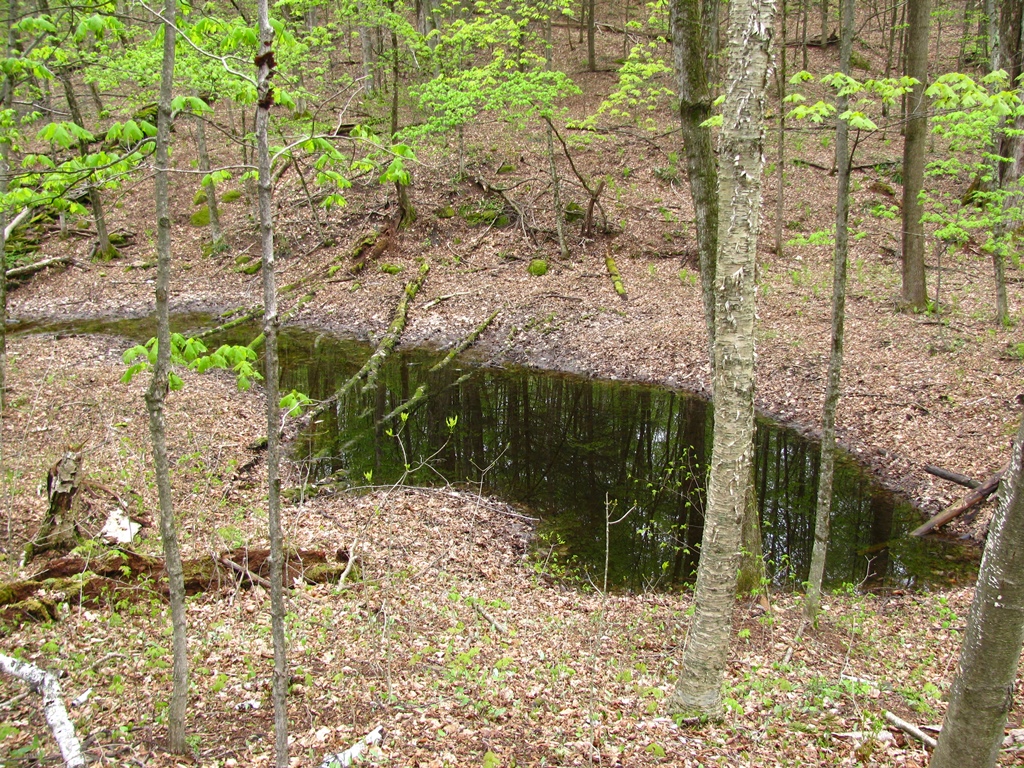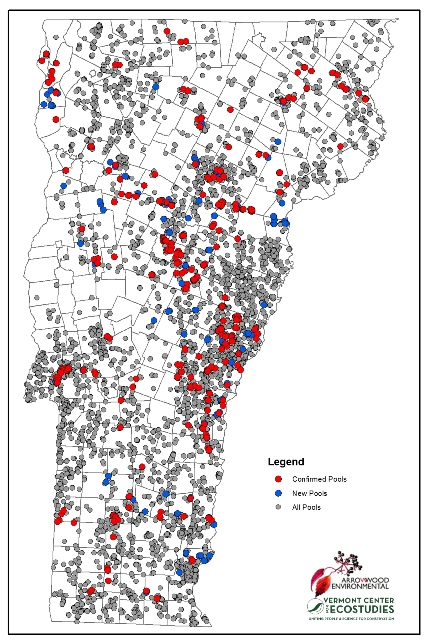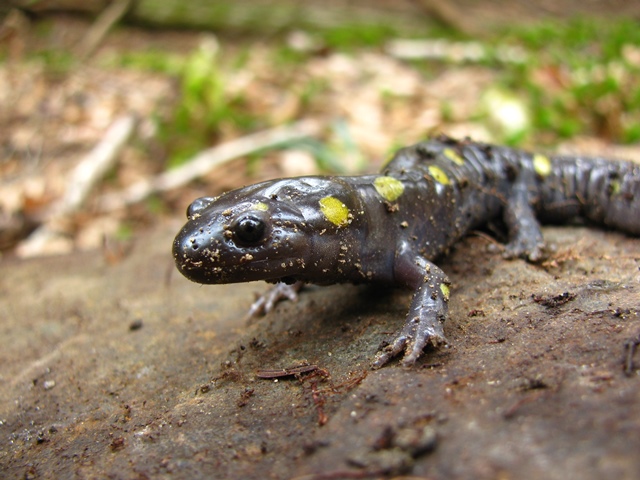
Vernal Pools, such as this one in Perkinsville, VT, are keystone ecosystems that support a rich diversity of invertebrates and breeding amphibians. Photo by Steven D. Faccio
The Vermont Vernal Pool Mapping Project (VPMP) is an ongoing effort to map the location and distribution of vernal pools in Vermont. These small, ephemeral wetlands support a rich assemblage of invertebrates and breeding amphibians, many of which are considered Species of Greatest Conservation Need (SGCN) in the Vermont Wildlife Action Plan. However, most vernal pools do not appear on National Wetland Inventory maps, and until now, their location and distribution across Vermont was largely unknown. VPMP, which was largely funded through the State Wildlife Grants Program of the Vermont Fish and Wildlife Department (VFWD), first mapped the location of nearly 5,000 “potential” vernal pools statewide using existing aerial photographs. Then, with the help of over 100 trained volunteers, 636 of those potential pools were field-visited; 344 of which were confirmed to be vernal pools. In addition, 221 unmapped pools were also confirmed during fieldwork.

Distribution of 344 field-verified “confirmed” vernal pools, 221 unmapped (“new”) vernal pools, and all other potential pools that were not field-visited. Click to enlarge.
Although field-verification of “potential” pools will continue over the next few years, results from the project’s first four years were recently compiled in a final report to the VFWD. Among other things the report revealed that the distribution of potential pools by biophysical region showed a distinct pattern, with the majority of pools (55%) occurring in just three regions; the Northern Vermont Piedmont, Southern Vermont Piedmont, and Southern Green Mountains (see map). Not surprisingly, just 5% of mapped potential pools were located in the Northeast Highlands, underscoring the limitations of aerial photo mapping in landscapes dominated by conifer cover.
Among field-verified pools, the most commonly detected species were Wood Frog and Spotted Salamander, which were found breeding in 78% and 73% of confirmed pools, respectively. Jefferson Salamander was found in 10% of confirmed pools, Blue-spotted Salamander in 3% of pools, and Fairy Shrimp in 5% of pools.
For more information about VPMP or to download the final report, visit www.vtecostudies.org/VPMP.

Spotted Salamanders were found breeding in 73% of field-verified vernal pools. Photo by Steven D. Faccio

Is there anything in regards to reporting the destruction of a vernal pool? I’m sad to say my neighbors had a beautiful one that they did not understand (not Vermonters) even though I told them what it was and they thought they could turn it into a swimming pond and it would fill with water. The next week after the excavators arrived the pool is destroyed and the water is murky and mostly dried up. 😓
Vernal pools that support breeding amphibians are Class II wetlands and therefore regulated by the VT DEC’s Wetlands Program. Any activities conducted within a Class II wetland or its buffer zone would first require a permit from DEC. If not, the activity is in violation of Vermont’s Wetland Rules. Visit the link below for more information about DEC’s permit process and wetland rules.
https://dec.vermont.gov/watershed/wetlands/jurisdictional/permit-info
Hi. I just checked the Vernal Pool map for Vermont and did not find a vernal pool in Williston, on our property at 1631 Oak Hill Rd, near Mud Pond. Does this interest you? Would someone be able to come out and verify that this is indeed a vernal pool?
Thanks for letting us know. You are correct, we have very few vernal pools reported from Williston, and none from the area around Mud Pond. We would be very interested in adding the pool at your property to the Vernal Pool Atlas. This can be done quite easily by visiting the VPAtlas site at https://vpatlas.org/. Registered users can then add a pool location by visiting the “Add Data” tab at the top menu and selecting “Add Mapped Pool” and following the prompts. Please feel free to get in touch with any questions.